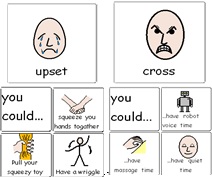Introducing the SCERTS model in Sheffield
Introducing the SCERTS model in Sheffield
-
You might have heard that something called SCERTS is increasingly being used with autistic children in Sheffield. This article explains what SCERTS is and how it works.
Who is it for?
The SCERTS model is for people with autism spectrum disorders and related disabilities, such as difficulties with communication or emotional regulation. It was initially developed for pre-schoolers and primary school age children, but can also be used with teenagers and adults. In Sheffield, SCERTS is being introduced into early years settings, primary schools and secondary schools (mainstream and specialist).
What is it?
SCERTS stands for Social Communication, Emotional Regulation and Transactional Support. It is not a specific therapy or programme. It is a model that helps families, teachers and therapists from different services to work together to teach children how to regulate their emotions and communicate with others. Without such an overarching approach, there is a risk that a child could end up with lots of different interventions with unconnected goals. The ultimate aim is to improve the quality of life for the child and their family.
How does it work?
At the start, a professional (such as a SENCO, a therapist or a teacher from an education advisory service) works with the class teacher to assess the child’s strengths and needs. They do this by observing the child and by talking to key people in the child’s life. Based on this assessment, parents, teachers and therapists decide together what outcomes they want to work towards, and the resources and strategies they will be using. These can be written into the child’s MyPlan or Education Health and Care (EHC) plan.
Resources can include things like visual timetables, PECS cards, or sensory tools. Strategies can come from a range of established autism interventions, like Social Stories, Floortime, More Than Words, Pivotal Response Training or TEACCH. Where possible, strategies are embedded into everyday routines in different social situations, rather than having an adult work with the child in isolation.
What is the role of parents in this?
Parents and family members play a key role as the experts in their child. You should be involved in your child’s initial assessment, in choosing the goals to work towards, and in implementing the strategies. You should be given resources you can use with your child at home. It is really important that SCERTS is used across all parts of your child’s life, not just in school.
How is SCERTS being introduced in Sheffield?
Some special schools in Sheffield have been using SCERTS for a number of years. In September 2018, the primary schools within the Fir Vale family of schools (Abbeyfield, Byron Wood, Hucklow, Whiteways, Owler Brook and St. Catherine’s) took part in a research project to trial the use of the SCERTS model in a mainstream school setting. This produced some positive results, and the model is now being rolled out across Sheffield.
So far, over 350 professionals have attended a two-day SCERTS training course (via Zoom, or face to face before the pandemic). This course was led by Emily Rubin or Amy Laurent, two of the creators of the SCERTS framework.
The professionals taking part in the training have included members of the Speech and Language Therapy Service, Educational Psychology, the Autism Education Team, SENCOs, teachers and teaching assistants, and members of the Neurodisability Team at Ryegate.
Some of these professionals are now taking part in additional training sessions that focus on adapting strategies to children’s sensory needs.
Please talk to your SENCO to find out if SCERTS is being introduced in your child’s school.
What do parents say about it?
A few years ago, we were able to offer free places on a SCERTS training course to our members. Here’s what they said:
“I had a fantastic two days attending the SCERTS training with Emily Rubin. I learnt so much about this model and was able to use much of what was discussed in encouraging my son’s speech and language at home. Although the SCERTS model has not been used in the schools my son has attended, I am thrilled that it is now being rolled out more widely in Sheffield. I know it will be of great benefit to many.”
“We attended the SCERTS training course and now use SCERTS exclusively in our son’s home education programme. We had to go to tribunal to get home-based SCERTS provision written into our son’s EHC plan, so that it would have to be funded by the local authority. The stress has been worth it, though, because our son has made incredible progress with it.”
-





